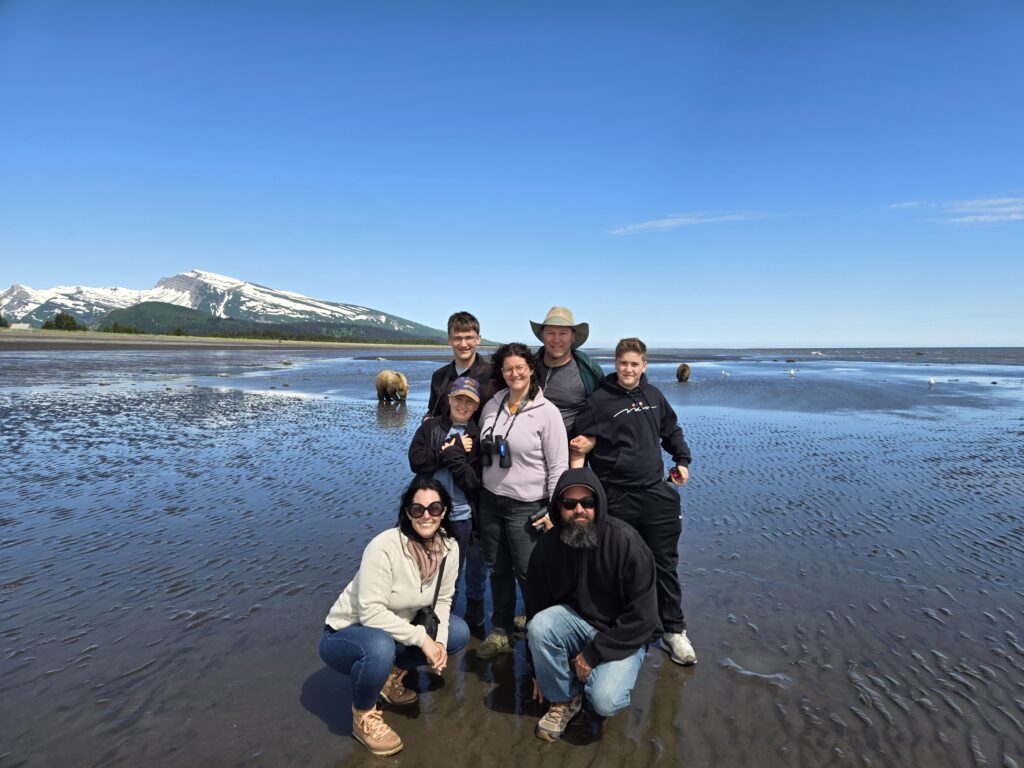
Seeking Clarity in the New Year: Lessons from Alaska’s Grizzlies
This past summer, during Edgility’s annual summer shutdown, my family and I took a trip we had been dreaming about for years. My husband, my three boys and I traveled to Alaska and visited The Kenai Peninsula. It’s one of those places that feels otherworldly—vast, rugged, and wild. While we had many signature Alaskan adventures, including dog sledding, glacier hiking and gold mining, the experience that stuck with me most was observing grizzly bears hunting for clams. We were close, like, really close… closer than one would think it would be reasonable to get to wild grizzlies. But against all odds, we weren’t nervous. When those bears are standing in the water, digging for clams as the tide goes out, it’s as if nothing else exists; not even five yummy humans posing for pictures right next to them. There’s something striking about their focus. They’re steady, patient, and clear about their purpose. They know what they’re there to do.
As I head into 2025 and all of the uncertainty that the world brings with it, I’m thinking about those bears and the clarity of their intentions. They weren’t distracted. They weren’t trying to do too many things at once. They focused on what mattered–finding the food they needed to survive. That clarity is something I want to hold onto, both personally and in my work.
And at this time of year, with the circumstances we’re currently facing, I think clarity is something many of us are seeking.
Why Clarity Matters
For mission-driven organizations—schools, nonprofits, and others—lack of clarity doesn’t look like grizzlies standing calmly in a stream. It looks like chaos. People uncertain about their roles. Teams frustrated by inequitable pay or confusing policies. Leaders trying to steer an organization without knowing who works best where or why.
The thing about clarity is that it’s not flashy. You might not even know you have it, until it’s gone. But it makes everything else work. When staff know what’s expected of them, when they understand what factors into their compensation, and when teams get how their work connects to the bigger mission, people settle in. They focus. They contribute. They stay. And clarity isn’t just about systems and structures—it’s also about confidence. When you’re clear, you stop second-guessing. You stop wasting energy trying to navigate a maze. You can trust the system and do what you were hired to do: make an impact.
The Grizzlies’ Lesson
The grizzlies in Alaska reminded me that focus isn’t about doing everything at once—it’s about doing what matters. The bears know that in the Summer, their job is simple: find food. They don’t overcomplicate it. They don’t chase after things that won’t feed them.
This applies to organizations too. Mission-driven leaders often feel pulled in a thousand directions. There’s so much need, so much work to do, and often not enough time or resources. It’s easy to get caught up trying to “do it all,” but that can leave your team scattered and frustrated.
Clarity helps you focus on the essential work.
For example:
- Compensation clarity means staff know they’re being paid fairly and understand how their effort ties to pay. That trust goes a long way.
- Performance clarity gives staff a clear understanding of what success looks like, so they can focus their efforts and amplify their impact.
- Structural clarity means staff are in the right roles, positioned to do their best work and contribute to the mission.
- Mission clarity keeps everyone anchored to purpose, even when the work gets hard.
What Happens Without It
I’ve seen what happens when organizations lack clarity. Staff burnout is high. Pay feels arbitrary. Leaders aren’t sure how to address turnover, so they scramble to fill roles, only to watch new hires leave. When structures and systems are unclear, people lose faith in the organization itself.
But this isn’t just about morale; it’s about outcomes. If people are distracted, uncertain, or frustrated, it impacts the work. The mission suffers.
On the other hand, I’ve seen what happens when organizations step back and prioritize clarity. It’s not overnight magic—it’s hard work—but the shift is real. Staff stay longer because they feel valued and understood. Leaders make decisions faster because they trust the systems in place. And organizations spend less time putting out fires and more time moving their mission forward.
Starting Fresh in the New Year
The New Year is a natural time for reflection. It’s a chance to look at where you’ve been and decide where you’re headed. If you’re a leader at a mission-driven organization, ask yourself:
- Do your staff understand their roles? Are responsibilities clear, or do people feel lost?
- Do you have a compensation strategy you can stand behind? If someone asked how salaries are set, could you explain it confidently?
- Are expectations for performance clear? Do your staff know what success looks like and how their contributions are measured?
- Is your team aligned with the mission? Does everyone understand how their work contributes to the bigger picture?
If the answer to any of these questions is “no” or even “I’m not sure,” you’re not alone. Many organizations struggle with these issues because they’re complex and hard to tackle while managing day-to-day demands.
But it’s worth the effort. Clarity doesn’t solve every problem, but it lays the groundwork for better decisions, stronger teams, and bigger impact.
Moving Forward
For organizations, increasing clarity might mean taking the time to clarify pay policies, reset roles and responsibilities, or rethinking how you support your staff. These aren’t quick fixes, but they’re foundational changes that can keep your organization steady, focused, and aligned.
The grizzlies reminded me that simplicity is powerful. And in a world that often feels overwhelming, clarity can make all the difference. That’s the lesson I’ll carry into the New Year: Start where you are. Decide what matters most. And then, with purpose and clarity, move forward.

Photos provided by Allison Wyatt.





